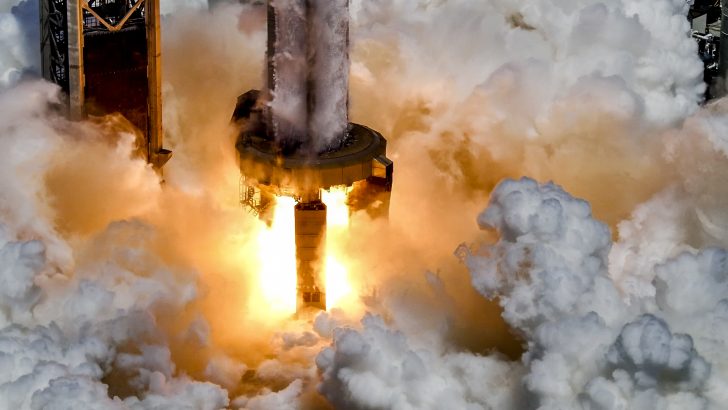The base of the Starship Super Heavy with the crucial water deluge system is visible during a static fire earlier this year. Image: SpaceX
With the year ending, SpaceX is in no mood to slow down its progress towards the highly anticipated third Starship integrated test flight. Starship is the world's largest rocket, and to date, SpaceX has tested several upper-stage spacecraft and two Super Heavy boosters in flight tests. SpaceX's second Starship fully integrated test flight took place in November, and it followed months of anticipation as the firm waited on government agencies to clear its pad for future tests.
Now, it looks like the third Starship test will take place much sooner than the second test did, as SpaceX has tested the second stage rocket again today in Texas.
SpaceX Runs Static Fire Of Starship Second Stage Again As It Prepares For Third Test Flight
SpaceX's Starship program needs to work as fast as possible in order to test and validate the systems and meet NASA's requirements for the Artemis program. The Starship second stage is a crucial part of the Artemis program as it is NASA's vehicle of choice to land astronauts on the Moon. To prove that the rocket can successfully land astronauts on the Mon, SpaceX has to successfully demonstrate Starship's ability to reach orbit and refuel itself in space before embarking on its lunar journey.
SpaceX, it appears, is aware of this. After the firm ran multiple vent tests at its launch site in Texas yesterday, it started off the day today by firing the upper stage's engines for a static fire. Since SpaceX has yet to confirm the event itself, it's unclear whether the test was a full-duration run and whether all of the rocket's six engines were tested. Based on an early look at the footage from local media, it appears that only one engine was fired.
However, the fact that the static fire happened can lead to another test happening today of the Super Heavy booster.
Looking at the local footage, it appears that the second stage Starship's engines were tested for six seconds. This is a typical duration for a static fire test, and it's easier for SpaceX to test the upper stage's engines since it has to load less fuel on the rocket.
With the test, SpaceX continues to fire on all engines. The firm launched its 96th rocket mission yesterday through two quick launches that marked the least time between two launches. SpaceX first launched its largest operational rocket, the Falcon Heavy, to send the Space Force's space plane on another test flight. It then followed up with a Starlink launch, leaving in play only one additional launch, according to details on the firm's website.
Starship is integral to SpaceX's future as well since the firm has staked the build-out of its second-generation Starlink satellite internet constellation on the rocket. Recent tests have also shown SpaceX flash the second stage's payload ejector bay that will also be used to launch Starlink satellites via a 'dispenser' like mechanism.



 CoinPedia News
CoinPedia News CoinPedia News
CoinPedia News CoinPedia News
CoinPedia News suncrypto.in
suncrypto.in TheCoinrise Media
TheCoinrise Media CoinPedia News
CoinPedia News BH NEWS
BH NEWS Optimisus
Optimisus DogeHome
DogeHome






















